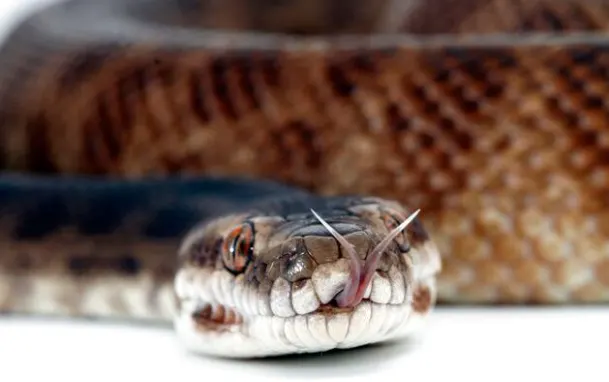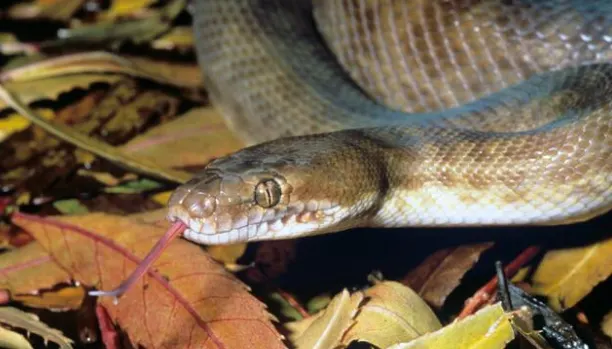The Children’s python, also known as Antaresia childreni, is a small, nonvenomous snake species native to Australia. Despite its name, this snake isn’t particularly designed for children; instead, it was named in honor of John George Children, a British zoologist. The Children’s python belongs to the Pythonidae family and is known for its wide distribution across Australia, especially in the northern regions. This species is not only fascinating due to its adaptability but also because of its relatively docile nature, making it a popular pet among reptile enthusiasts.

Table of Contents
Key Characteristics
- Size and Appearance: The Children’s python typically measures around 3 to 4 feet in length, with some individuals reaching up to 5 feet. It has a slender body covered in smooth scales, which vary in color from light brown to caramel, with darker spots that become more muted as the snake matures. The scales exhibit an iridescent sheen when exposed to sunlight, adding to the snake’s visual appeal. Its head is relatively small, with heat-sensing labial pits that aid in detecting warm-blooded prey.
- Behavior: This python is nocturnal, meaning it is most active during the night. It is a semi-arboreal species, often found climbing trees, rocks, or even cave walls, especially when hunting for
food . Although generally solitary, the Children’s python is known to be more defensive than aggressive, particularly when it feels threatened. - Diet: The Children’s python primarily preys on small mammals like rodents and bats, as well as birds, lizards, and frogs. It is an ambush predator, relying on its ability to blend into its surroundings to catch unsuspecting prey.
Habitat and Distribution
Children’s pythons are highly adaptable and can thrive in a variety of habitats, including coastal woodlands, shrublands, deserts, and rocky areas. They are commonly found in the northern regions of Australia, with the Stimson’s python variant extending their range even further into the arid interior of the continent.
Reproduction
Mating season for Children’s pythons occurs in May and June. Females lay eggs toward the end of the dry season, usually in July or August. A typical clutch consists of 5 to 25 eggs, which the female incubates by coiling around them to maintain a consistent temperature. After about 50 days, the eggs hatch, and the young pythons, known as neonates, are immediately independent.
Conservation and Human Interaction
The Children’s python is listed as a species of “Least Concern” by the IUCN Redlist, meaning it currently faces no significant threats to its survival. This status is partly due to the snake’s adaptability to different environments and its stable population across its native range. However, Australia’s strict wildlife protection laws, implemented in 1999, have made it illegal to export these snakes, meaning that those kept as pets outside of Australia are either very old or captive-bred.
Children’s Python as Pets
Due to their manageable size and generally docile nature, Children’s pythons have become popular pets. They are relatively easy to care for, requiring a habitat that mimics their natural environment, with plenty of hiding spots and a controlled temperature range. However, potential owners should ensure they are obtaining captive-bred snakes from reputable breeders to avoid legal issues and to promote ethical practices.

FAQs about Children’s Python
- Are Children’s pythons venomous? No, Children’s pythons are nonvenomous and pose no significant danger to humans.
- How do they hunt? They are ambush predators, often lying in wait for their prey. However, they can also actively forage if necessary.
- Are they aggressive? While not aggressive, Children’s pythons can be defensive, especially when threatened. As a small species, they are naturally more cautious.
- Where can they be found? They are native to Australia, with a wide distribution across the northern regions and into the interior.
- What do they eat? Their diet consists of small mammals like rodents and bats, as well as birds, lizards, and frogs.
The Children’s python is a remarkable species that exemplifies adaptability and resilience. Whether admired in the wild or kept as a pet, this python offers a glimpse into the fascinating world of reptiles, showcasing the unique beauty and behavior of one of Australia’s most widespread python species.
- Enchi Ball Python: A Unique and Stunning Morph of Python regius - March 27, 2025
- Emerald Tree Monitor: The Enigmatic Green Guardian of the Rainforest - March 26, 2025
- The Egyptian Cobra (Naja haje): A Fascinating Serpent - March 25, 2025
